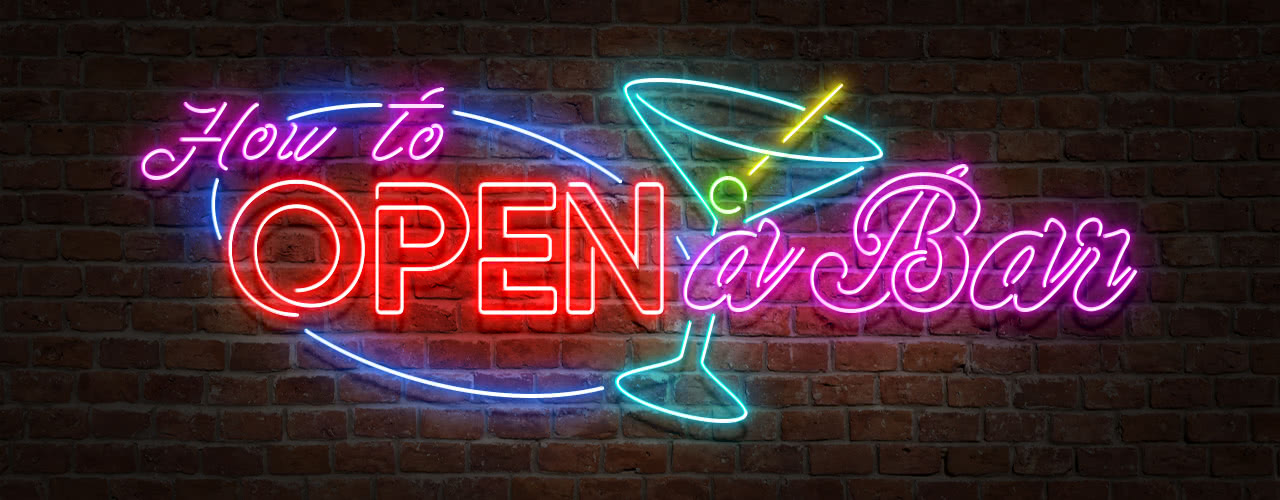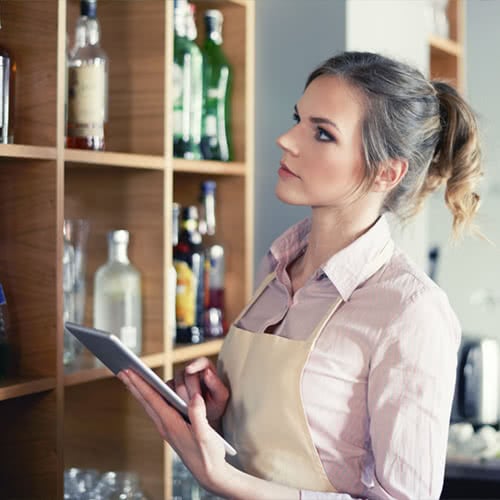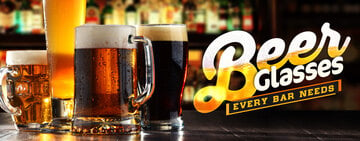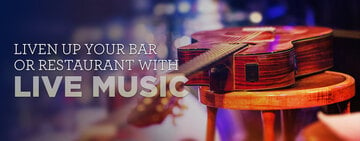
Have you been dreaming of opening your own bar but you’re not quite sure where to start? You’ve probably thought about your concept and your name, but maybe you’re unsure about some of the finer details, like how to obtain funding and permits. Running a successful bar can be lucrative and rewarding, as long as you perform some careful research and follow the correct steps. We outline the process of starting your own bar, from the initial concept to your grand opening, so you can fulfill your dream of becoming a bar owner.
Shop All Bar SuppliesHow to Open a Bar
Opening a bar requires some initial research and planning. You can make sure that you're covering all the bases by following our bar opening checklist below.
- Choose a Bar Concept and Brand
- Choose a Name for Your Bar
- Choose a Business Entity for Your Bar
- Write a Bar Business Plan
- Secure Funding for Your Bar
- Find the Perfect Location
- Obtain Permits and Licenses
- Find a Liquor Supplier
- Design a Bar Layout
- Buy Your Equipment and Supplies
- Hire the Right Staff
- Advertise Your Bar
- Host Your Soft Opening
1. Choose a Bar Concept and Brand
 The fun part of starting your own bar is creating your concept and brand. Your concept includes all the general ideas you have about what kind of bar you want to open. Your brand is slightly more defined and encompasses the identity and mission of your business. Every detail of your bar should support your brand, from your service style to your decor and ambiance. A good question to ask yourself is how do you want people to feel when they walk in your bar?
The fun part of starting your own bar is creating your concept and brand. Your concept includes all the general ideas you have about what kind of bar you want to open. Your brand is slightly more defined and encompasses the identity and mission of your business. Every detail of your bar should support your brand, from your service style to your decor and ambiance. A good question to ask yourself is how do you want people to feel when they walk in your bar?
Here are some examples of bar concepts to get you thinking about your own bar:
- An unpretentious neighborhood bar with comfortable booths and a jukebox of classic hits, where folks can unwind after work.
- A barcade with vintage pinball games that serves only a few types of beer, where guests can let loose and have fun on a Friday night.
- A moody martini bar with neon lights and hypnotic music, where guests can feel like they’re part of an exclusive club.
- A sophisticated wine bar with modern furniture and art on the walls, where guests can sip flights of wine paired with appetizers.
The most important thing to note is that your concept and brand should be in line with the demographics of your chosen location. When you get to the step of performing market research, you may have to adjust your brand to meet the needs of the neighborhood you are serving.
2. Choose a Name for Your Bar
Choosing the name for your bar can feel like the moment that your dream is becoming a reality, but how do you choose the right name? Make sure that it’s catchy, make sure it reflects your brand, and make sure it’s unique. Remember that your name will be used on all of your marketing materials and merchandise, including menus, staff uniforms, and advertisements. Stay away from names that are too long and complicated.
After you’ve chosen a name that represents your bar perfectly, it’s time to consider trademarking it. This protects your name from being used by any other businesses, which can be helpful if your location is in a high-density area. It’s especially important if you plan to expand your business to multiple locations in the future.
3. Choose a Business Entity for Your Bar

Every business owner has to decide what type of entity or business structure to establish. This impacts your legal liability, your ownership rights, how your business is taxed, and your funding options. These are the common entity types for small business owners:
- Sole Proprietorship - This is the most common type of structure for small businesses and requires no paperwork to set up. Once you start a business that operates for profit, you are automatically running as a sole proprietorship. The downside of this entity is that as the bar owner, you are liable for any lawsuits against your business.
- Partnership - A verbal agreement between two or more taxpayers is all that’s needed to start a partnership, which makes it very appealing. However, you are liable for the mistakes of your partner so it’s recommended that you go ahead and create a partnership agreement anyway. Always have a lawyer review your partnership agreement before signing.
- Limited Liability Company - Also known as an LLC, this type of business entity is very popular due to its liability protection. Because an LLC exists as its own separate legal entity, the business owner isn’t liable for any lawsuits against the business. The downside of an LLC is that it does require the proper forms and a fee to be filed with the Secretary of State’s office.
4. Write a Bar Business Plan
This is the point where you need to sit down and get your business plan on paper. Having a thorough business plan is going to help you when you reach out to investors and apply for loans. It’s also a great way to work through any areas of uncertainty you may have about how your business is going to operate. A bar business plan should include the following:
- Executive Summary
- Company Overview and Description
- Market Analysis
- Business Offerings
- Management
- Marketing and Public Relations Strategies
- Financial Projection
5. Secure Funding for Your Bar
After doing your financial projection you’ll have a better idea of the funding you’re going to need to make your dream happen. Make a list of all the startup costs required to get your bar running. Then add in the cost of daily operations, including the cost of alcohol, salaries, utilities, and rent. From there you can create a budget and forecast how much money you’ll need to keep your bar running for the next year.
Next, determine how much money you have to put towards your startup costs and how much additional funding you’ll need. Now that you have a definitive number, you can begin the process of applying for loans. The initial investment that you make could be paid back within a few years if you run your bar successfully.
6. Find the Perfect Location

Performing a location analysis is the best way to find the perfect location for your bar. There are many factors to consider, but these are some of the most important:
- Target Demographics - You should either begin by targeting a location with demographics that match up with your concept, or base your entire concept off of the demographics of a predetermined location.
- Health Regulations and Zoning - Zoning regulations can vary greatly between cities and counties. Make sure to become familiar with your location's zoning laws so you know what to expect.
- Visibility and Access - It’s extremely important to choose a location that is visible to people driving or walking by. Accessible parking is always optimal.
- Nearby Competition - If an area is already saturated with bars, you may want to either choose a different location, or make sure your bar has a unique concept that stands out.
7. Obtain Permits and Licenses
Making sure you have the appropriate licenses may be the most tedious step along the way, but it’s vital to getting your bar open for business. It never hurts to enlist the help of legal counsel to make sure you have all the bases covered. The number of permits you’ll need and the total cost of fees will vary by state. These are some of the most important licenses required:
- Employee Identification Number - You’ll need an Employer Identification Number, or EIN, to apply for many of the permits below. This number identifies you as an employer and allows you to officially hire your staff. To obtain your EIN, visit the IRS website and fill out their online application.
- Liquor License - Without a liquor license, you can’t legally sell alcohol. Not only does the license permit you to sell alcoholic beverages, it also determines what type of alcohol you can sell and the times and days you can operate. The process for obtaining one can be lengthy, so you should start on this one right away by contacting your state’s Alcoholic Beverage Control agency. Or, consider starting a zero-proof bar, and you can skip this step.
- Foodservice License - If you plan on serving food at your bar, you’ll need a foodservice license. This ensures that your business meets food safety laws and regulations. To obtain a foodservice license, apply online at your state government’s website.
- Alcohol and Tobacco Tax and Trade Bureau - Referred to as the TTB, this federal agency regulates businesses that sell alcohol. Before you open for business you’ll need to register with the TTB, which can be done on their website. The TTB also requires that you keep a record book containing the date and quantity of all alcohol received from your suppliers. This step is very important because if you get inspected by a federal officer and fail to produce the log book, you could be fined up to $10,000.
- Sign Permit
- Music Permit
- Certificate of Occupancy
- Pool Table Permit
- Dumpster Placement Permit
8. Find a Liquor Supplier

With most of the paperwork out of the way, it’s time to make a wish list of the spirits, beer, or wine that you want to stock in your bar. You might already have a selection in mind or you could do some research to see what’s popular in the area. The concept of your bar might weigh heavily in this decision, especially if you’re going to specialize in one type of alcohol, like craft beer or small-batch wines and spirits.
You’ll want to find an alcohol distributor that offers the brand and products you have on your wish list. Many wholesalers have websites with portfolios that showcase all their products and pricing. Here are some things to keep in mind when you choose a distributor:
- Brand selection
- Minimum purchase requirements
- Payment terms and discounts
- Delivery dates
- Availability of brand ambassadors or promotional materials
Once you stock your bar with alcohol, you should begin to take liquor inventory so that you can maintain the appropriate quantities. Taking consistent liquor inventory will give you an idea of how your bar is performing, what your par levels should be, and which products are selling.
9. Design a Bar Layout
If you’re designing your bar from scratch, the best thing to do is take measurements of the entire space. You can draft the layout on paper or take advantage of design software to come up with a virtual blueprint. Having the blueprint is going to help you choose fixtures, equipment, stools, and seating that will fit inside your space.
Keep in mind that the space should remain functional. Your staff should be able to move freely around any tables or booths. The area behind your bar should have enough space for liquor displays, speed rails, and bottle coolers. You should also allow enough room for the maximum number of bartenders on your busiest shifts.
When it comes to choosing your decor, make sure it supports your brand and concept. Artwork, lighting fixtures, and furniture can all be used to create an experience for your guests. Check out current design trends to come up with ideas.
10. Buy Your Equipment and Supplies
You’ll need to outfit your bar with some basic equipment in order to serve drinks. It’s important to factor in the space and electrical requirements you’ll need for these items:
- Bottle Coolers - These back bar coolers provide space for all the bottles and cans that you’ll need to keep chilled. Ideally, the bottle cooler will sit under your bar so that bartenders can access it quickly.
- Ice Machines - It’s going to take a lot of ice to keep the beverages flowing at your bar. You’ll need a reliable ice machine to produce large volumes of ice throughout the shift.
- Ice Bins - Once your ice machine makes the ice, you’ll need to store it in a place that’s convenient for your bartenders. Under bar ice bins fit beneath the bar so your staff can easily access ice for cocktails and blended drinks.
- Glass Washer - Having a glass washer under the bar is extremely convenient. Some models are designed to fit inside an underbar sink and require no electricity.
- Bar Blender - You’ll need a reliable, commercial-grade bar blender for making popular blended drinks like daiquiris and margaritas. Look for a model with a cover to reduce noise while blending.
- Beer Dispensers - Your bar isn’t complete without a beer dispenser. These units feature a refrigerated cabinet that holds your beer kegs, while the beer is dispensed through a tap tower on top of the dispenser.
In addition to your bar equipment, you'll also need to stock up on other bar essentials. Make sure you have the appropriate glassware to serve your beverages. Depending on your menu, you might need garnishes, drink ingredients, and cocktail mixes. For your bar top, you'll need cocktail napkins, coasters, and stirrers.
11. Hire the Right Staff

Different types of bars may have different staffing needs. For instance, a large nightclub will require some additional employees that a small neighborhood bar won’t need, like bottle service staff or a house DJ. If you own a wine bar, you might want a sommelier on staff. Here are some of the key positions that you’ll need to get most bars up and running:
- Bar Manager
- Bartenders
- Barbacks
- Servers
- Host / Hostess
- Security / ID Checker
Many potential employees are enthusiastic to start a new venture and get in on the ground floor of a new bar. With such a high turnover rate, the best way you can keep your stellar bartending staff is by defining your workplace culture from the very beginning. In addition to interviewing and hiring new employees, make sure that you create a thoughtful training program that outlines clear expectations.
A critical part of bar ownership is ensuring that your staff is well-trained to look for signs of visible intoxication. Your training program should emphasize these signs and provide guidance on how to deal with intoxicated patrons. It's your responsibility to make sure that your guests are safe at all times, while they enjoy drinks at your bar and when they leave your bar.
12. Advertise Your Bar
You’ve done your due diligence and now you’re ready to let the community know about your new bar. This is where the critical step of advertising and marketing your bar comes into play. Here are some tips you can use to inform your potential customers about your business and build excitement about your opening day:
- Create a website – Building a website for your bar is essential. Many customers will be researching your business online before making a visit, so you should provide key information on your site. Your site should also be representative of your brand.
- Use social media – Another way to reach potential customers is by creating accounts on social media platforms like Facebook, Twitter, and Instagram. You can share high-quality photos of your signature cocktails and advertise promotions.
- Make a Yelp account – Create a business profile on Yelp so that you have more online visibility and customers can submit reviews for your bar. You can personally ask your guests to leave reviews by putting a request on your bar receipts.
- Sign up for Google My Business – Google My Business is a free service that ensures your bar information will show up in Google searches and on Google Maps. Make sure to provide as much information as possible, including your website, hours, photos, and price ranges.
- Use your store front – As you’re doing construction on your new bar, passersby will be naturally curious about your new business. Make sure to utilize posters and sidewalk signs to provide information about your bar and the opening date.
- Place an ad in the local paper – Purchase advertising space in the local newspaper to share information about your new bar. You could even include a coupon for half-off drinks.
- Create a loyalty program – Sign up for a mobile app loyalty program and reward your guests for their continued business. If you specialize in craft beers, provide a way for guests to track and rank the beers they’ve enjoyed at your bar.
- Promote a Happy Hour – Happy hours are a great way to attract customers through value-priced drink specials. You can also offer complimentary samples and free snacks.
- Host an event – There are a variety of events you could host in your bar to create some buzz. If you own a wine bar, consider hosting a wine tasting. If you own a tap house, trivia nights can be very successful at bringing in more customers. Don’t forget the most important event of all, your grand opening!
13. Host Your Soft Opening
A soft opening is a practice run that allows your bar staff to test out their operation on a limited number of guests before the actual grand opening. The benefit of a soft opening is that it gives you an idea of what you are doing right and what areas of your service may need more attention. Your staff gets the opportunity to practice without the pressure that comes with a busy opening day. An easy way to host a soft opening is to invite the friends and family of your employees for a sneak peek event.
Now that you’ve become familiar with all the steps necessary to opening a bar, you can begin to make your dream a reality. By planning every aspect of your bar operation ahead of time, you can start your business off on the right foot.





